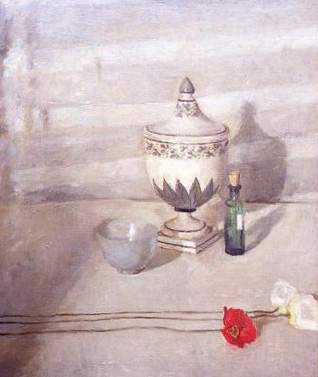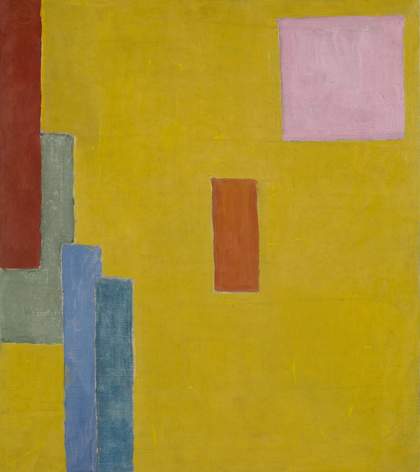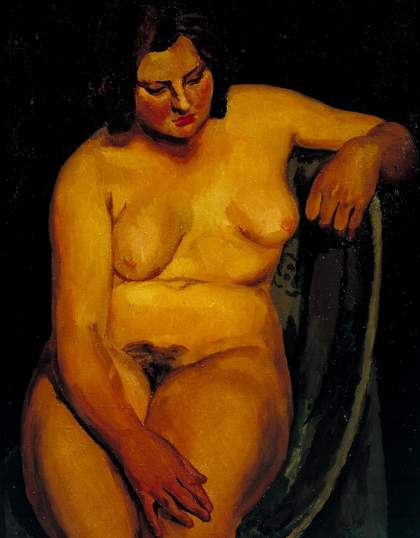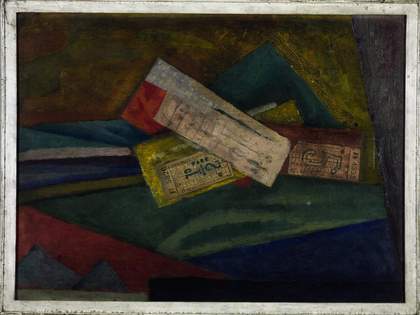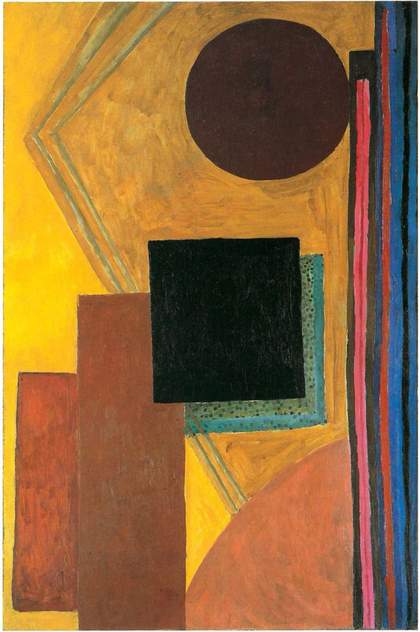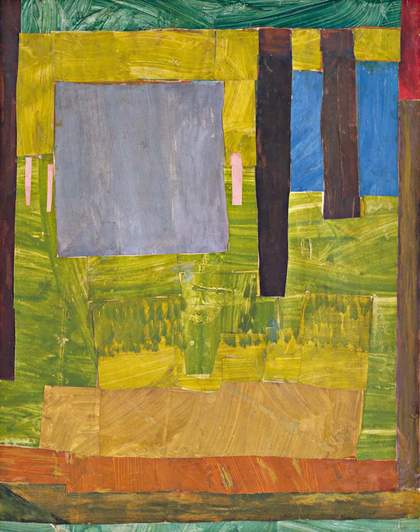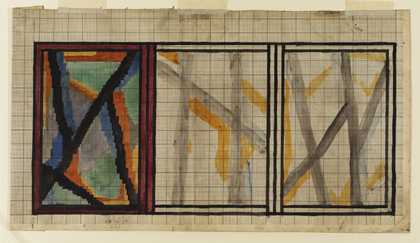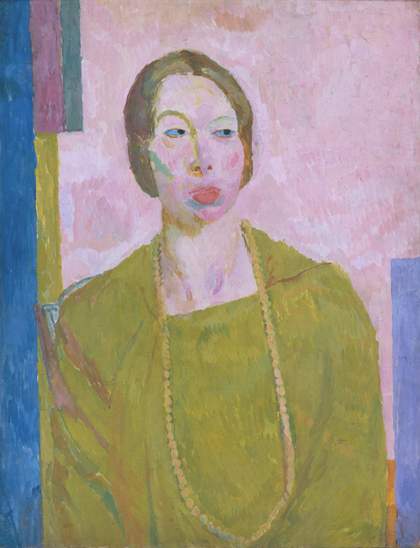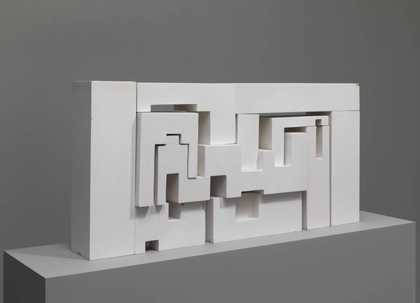When Vanessa Bell (1879–1961) took stock of her work towards the end of her life, she drew up an inventory that spanned some fifty years of painting and applied art.1 Her style had ranged widely, from early tributes to modern masters like James McNeill Whistler, as seen in her Iceland Poppies c.1908–9 (fig.1), to mid-career experiments in abstraction such as Abstract Painting c.1914 (Tate T01935; fig.2) and then the more legible figuration of her later years (see Nude c.1922–3; fig.3). The process of looking back must have seemed, to some extent, like remembering the work of several different artists. In the case of Abstract Painting, she felt obliged to add an explanatory gloss after the title: ‘(Test for chrome yellow)’. With its overlapping oblongs of maroon and different shades of blue anchored to the left and bottom sides of the canvas, and its free-floating blocks of brick red and candy pink, all in a rich expanse of saturated yellow, the painting is a brilliant study in colour contrasts. Yet it is also a test of other qualities and ideas that are crucial to our understanding of Bell’s work in the 1910s, and of wider developments in modern art.
Abstract Painting is, on the one hand, an extreme example of abstraction, in the sense that it seems to repudiate the subject matter of lived experience. It could be described as ‘purely abstract’, to employ the loaded phrase that Bell used in relation to Duncan Grant’s Abstract Kinetic Collage Painting with Sound 1914 (Tate T01744).2 Yet it also calls into question the possibility of any such purity by accumulating associations in the mind of the viewer, whether personal or historical, that run against the notion of a non-referential work of art. The purpose of this In Focus project is to explore the different ways in which Abstract Painting puts abstraction to the test: how it makes an early, even ‘precocious’ intervention into the international debate about abstract art, pushing the hypothesis that art can be autonomous to its limit;3 and how it works simultaneously to conjure up ideas about modern life and how it might be lived. The dichotomy is one that lies at the heart of the critical debate about modernism and the extent to which it could really be ‘isolated in its own aesthetic field’, as the art historian Christopher Green has put it in an analysis of cubism that questions the ‘caricature’ of modernist painting as necessarily flat.4
Bell’s thinking and process of composition are evident in the very material of Abstract Painting. To create it, she drew a pencil sketch on the canvas, which she then overlaid with oil paint and gouache (a rich, opaque watercolour). The fact that she left the work unvarnished, with no inscription to indicate its correct orientation, suggests that she never intended it for sale or public exhibition. The present orientation has been inferred from the direction of the brushstrokes, which gives the vertical, and from the thickness of the paint, which increases at the bottom ends of the coloured rectangles.
During Bell’s lifetime the painting remained in her possession, a private experiment which she shared only with her immediate circle of ‘Bloomsbury group’ friends. It was also a collaborative experiment. She worked alongside Duncan Grant and Roger Fry, her partners at the Omega Workshops Ltd interior design company, to create a collective corpus of abstract and semi-abstract painting, which included works such as Grant’s Interior at 46 Gordon Square c.1915 (fig.4) and Fry’s Essay in Abstract Design1915 (fig.5). We know that Bell was working on Abstract Painting in late August 1914 because Grant later remembered that she did so concurrently with his own work on Abstract Kinetic Collage Painting with Sound.5 He added that he could not remember which of them had made the first move into absolute abstraction. In the next few months there followed a handful of abstracts by Bell, just four of which survive. They included another painting on canvas, Abstract Composition 1914 (fig.6), which, like Abstract Painting, sets up a dramatic contrast between richly coloured shapes and a bright yellow background; and Composition c.1914 (fig.7), a study in green, which used the recently invented cubist technique of papier collé (a collage consisting of pasted scraps of paper) to juxtapose different textures of brushwork.6
It was not until 1973 that Abstract Painting first appeared in public, when the dealer Anthony d’Offay included it in a Bell retrospective designed to raise the profile of the artist’s modernist work.7 Tate’s decision to buy the painting in 1974 put institutional weight behind his campaign. Since then, it has become central to Bell’s oeuvre, ‘much the finest of Bell’s surviving works in this style’, as the Bloomsbury scholar Simon Watney puts it, and a key work in the broader histories of British art and European modernism.8 When in 2012 the Museum of Modern Art (MoMA) in New York staged a massive survey of the birth of the international abstract movement entitled Inventing Abstraction 1910–1925, it gave Abstract Painting ‘a position at the forefront of non-objective art’, as the art historian Matthew Affron observed.9 The art historian Lisa Tickner, writing about the Bloomsbury abstracts more broadly, also placed them ‘at the forefront of European modernism’, arguing that ‘neither Picasso nor Braque made the same move to abstraction in their collages nor adopted the vivid colouring of Omega’s decorative aesthetic’.10
Here Tickner intervenes in a political debate about art and national identity by arguing against the assumption that British art of the period was backward and provincial. Watney likewise presents Bell’s experiment in abstraction as a political, cosmopolitan gesture, one that ‘firmly marks her allegiance to a European avant-garde’.11 Inventing Abstraction opened with an enormous diagram, mapping the relationships between artists represented in the exhibition.12 In this schematic representation of multiple encounters, journeys and correspondence, Bell connects with Pablo Picasso in Paris and Mikhail Larionov and Natalia Goncharova in Russia, as well as with Grant and members of the vorticist group in London. She knew the work of others on the MoMA map – Wassily Kandinsky, Frantiŝek Kupka, Fernand Léger – through exhibitions and journal publications.13 MoMA’s emphasis on multiple international networks reacts against the linear model of modernism proposed by Alfred H. Barr in the exhibition Cubism and Abstract Art (MoMA, 1936); and also against the structure of segregated national schools that was used, for example, by the Tate Gallery in its exhibition Abstraction: Towards a New Art, Painting 1910–20 (1980), where visitors were invited to ‘tour each country separately’.14
Bell herself was highly conscious of her position as a British artist working against the traditions and outside the institutions of a British school of art. She was wary of what she called ‘the usual English sweetness … coming in and spoiling all’, particularly when she considered Bloomsbury group painting alongside that of ‘Derain, Picasso, Matisse, etc.’.15 In 1918 she told her sister, the writer Virginia Woolf, that ‘there is no-one worth considering as a painter in England today … even with whom it’s worth discussing one’s business. In France this is reversed.’16 This conversation took place in March 1918, in the thick of a seemingly interminable First World War. Yet when Bell made Abstract Painting in 1914, that war had only just begun. The mood of cultural reaction that was triggered by the conflict generated a new, more dangerous context for the making of modernist art. As Bell remembered: ‘the excitement and the joy had gone. The hostility of the general public was real now; no longer a ridiculous and even stimulating joke.’17 In such circumstances, the denial of representation in Abstract Painting becomes in itself an oblique commentary on the world outside the painting, and a form of resistance to the cultural politics of the war.18
‘The air is teeming with discussion on art’, Bell reported to Woolf in a letter of 6 February 1913 that conveys the risk and uncertainty surrounding the new art, as well as the intense excitement that it generated:
They think they are getting further. I don’t know. Roger’s views of course are more mature than ours. He is at one pole and Clive [Bell, Vanessa’s husband] at the other and I come somewhere in between on a rather shaky foothold, but none of us really agree with Leonard [Woolf, Virginia’s husband], whatever he may say to the contrary, and Duncan tells me it is a gross libel to say that he does either. So your husband had better reconsider his position, I think. We shall go on till doomsday I suppose.19
Bell made her experiments in abstraction under pressure from the competing demands of formalism and representation, and she was unusual in her willingness to give form the priority. As she put it in a letter to Leonard Woolf: ‘it can’t be the object of a great artist to tell you facts at the cost of telling you what he feels about them.’20 She explained that form mattered to her far more than content when she looked at a picture: that she was quite capable of seeing the shapes and colours in a work, without noticing what they were meant to represent. But she also conceded that the world could be a rich source of visual inspiration, because ‘certain qualities in life, what I call movement, mass, weight, have aesthetic value’.21 The letter works well alongside the abstracted portraits and figure paintings that she made in 1912, such as Studland Beach (Tate T02080) and Frederick and Jessie Etchells Painting (Tate T01277). It is consistent with the predominantly figurative nature of her work, and with her comment in later years that she regretted the ‘loss’ of subject matter in abstract art.22 Yet it leaves us searching for an explanation for her apparently sudden conversion to absolute abstraction in the autumn of 1914.
The Tate Gallery exhibition The Art of Bloomsbury (1999) demonstrated a relationship between Abstract Painting and Bell’s other, contemporaneous work, by hanging it among the designs that she made for the Omega Workshops in 1913 and 1914. Established by Fry in 1913 and directed by Fry, Bell and Grant, the Omega aimed to bring the spirit of European modernism into the British home by employing progressive young artists to decorate and design furniture and textiles.23 Abstract Painting clearly belongs with textiles that Bell designed for the Omega, which present entirely abstract arrangements of coloured shapes, such as Preliminary Design for Lady Hamilton Rug 1914 (fig.8), which formed the basis for Carpet 1914 (Victoria and Albert Museum, London). As the art historian Christopher Reed points out, the technique of working out textile and marquetry designs on gridded paper that was required for commercial production of the Omega wares strongly resembles the flat, geometric arrangements of the Bloomsbury artists’ abstract easel paintings. The fact that it is sometimes impossible to differentiate between studies for the paintings and for Omega designs demonstrates how much the two practices had in common.24
Reed changed the terms of the debate about Abstract Painting when he argued that the Bloomsbury artists’ abstracts were ‘a direct result of their engagement with domesticity’ at the Omega Workshops, rather than a response to the formalist theories that they debated so vehemently; and moreover, that their unconventional sense of home amounted to ‘the basis of a new social and aesthetic order’.25 His analysis of the radical politics that underpinned Bloomsbury’s reinvention of domesticity – their commitment to an ‘anti-authoritarian individualism’ that shaped every aspect of their lives, from their art and aesthetics to the way they furnished their houses and conducted their relationships – points, once again, to an unexpected political subtext for the apparently apolitical structures of Abstract Painting.26 In this reading, abstraction becomes shorthand for a liberated, modern way of life that permeates Bell’s figurative painting, as well as her abstracts and Omega designs. In her 1915 Mrs St John Hutchinson (fig.9), for example, the abstract background, which so strongly resembles the composition of Abstract Painting, becomes an emblem of modernity, ‘giving visual form to the desire to create environments where life – and especially women’s life – can be lived in a modern way’, in the words of Reed.27
The contextual, historicising method employed by Reed and other Bloomsbury scholars works knowingly against the formalist aesthetics developed by Roger Fry and Clive Bell; in other words, against their conviction that the fundamental properties of art are universal and against their willingness to make comparisons between works based on their visual affinities alone.28 In 2014, however, Tate Modern revisited Fry’s method by displaying Abstract Painting alongside the sculpture Poem Wall 1963–5 (fig.10) by the Lebanese artist Saloua Raouda Choucair (born 1916).29 The comparison was deliberately ahistorical, a pairing of artists ‘from different periods and different locations who were both pioneers of abstraction in their own place and time’, according to the display text.30 The effect was not simply to encourage a formal analysis of the objects as removed from their contexts, but to raise questions about those contexts arising from the particular, material features of the work. In the case of Abstract Painting, it drew attention to the binary qualities of flatness and depth that were fundamental to debates about modernism throughout the twentieth century.
Set beside Poem Wall, with its pattern of loosely interlocking, rectilinear blocks and voids, Bell’s ‘flattened … study in frontal geometry’, in the words of Affron, became an exploration of chromatic depth.31 The jutting and receding surfaces of Choucair’s white-painted wall create a richly modulated tonal palette out of light and shadow. Spatial relationships generate an approximation to colour that brings sculpture and painting closer together. In Bell’s painting, the same process is reversed: colour relations generate a sculptural effect through the optical illusion of recession and projection from the flat plane of the canvas. The pink square floats forward from the yellow field; the turquoise pushes up from under the darker oblongs that appear to overlay it.
At the same time, however, Bell has used the tactile, material qualities of paint and canvas to emphasise the actual flatness of the work. Once again, the comparison with Choucair accentuates certain features of her painting. Her brushwork is thin and applied without impasto, revealing the canvas’s weave. Shapes loosely abut, rather than overlapping one another. The expanse of yellow could be read as a background, or as a complex shape in its own right, jagged on the left-hand edge and punctured by the pink square and brick-red oblong. The shapes in the centre-left, which we take to be simple rectangles when we accept the illusion of depth in the image, are in fact irregular polygons, much like the crenellated blocks in Choucair’s sculpture. Likewise, the hair’s-breadth of bare white canvas that rims the shapes in Abstract Painting finds its negative in the shadowy black crevices between Choucair’s blocks. The apparent lack of finish is deliberate. Both artists could easily have smoothed over the gaps. In Choucair, this evokes her grounding in Sufi poetry, with its interlinking of discrete parts.32 In Bell, it exposes the difference between the physical reality of the canvas as a flat surface decorated with adjacent patches of colour held slightly apart from one another, and the illusion of depth that it is capable of supporting.
It was a difference that Bell never tried to resolve, preferring to remain, as she put it in her self-deprecating way, ‘somewhere in between on a rather shaky foothold’.19 Ultimately, the relentless logic of abstraction, defined as the absolute priority of form over subject matter, did not interest her, any more than it really interested Fry.33 Some historians have therefore characterised her abstract phase as an arid intellectual exercise, emotionally limiting and therefore quickly abandoned.34 But on closer inspection, it becomes apparent that Bell’s abstracts do not deliver the sort of ‘conceptual purity’ that the idea of absolute abstraction demands.35 They are vital, sensuous paintings, with their rich colours and textured brushwork, not so much the ‘struggle toward the immaterial’ that Kandinsky proclaimed in 1911, as a celebration of the material of paint and the process of painting for their own sake.36 They are also equivocal, inquisitive works, ‘profoundly saturated’, as Watney remarks of Abstract Painting, ‘with ideas concerning the nature and status of painting itself’.37 The following essays pursue some of those lines of enquiry, as they lead us deeper into the work and out into the world in which it operated.
Notes
1. The inventory was made in 1951 and is referenced in Richard Shone, The Art of Bloomsbury: Roger Fry, Vanessa Bell and Duncan Grant , exhibition catalogue, Tate Gallery, London 1999, p.160.2. Vanessa Bell, letter to Roger Fry, 24 August 1914, in Regina Marler (ed.), Selected Letters of Vanessa Bell , London 1994, p.169.3. Matthew Affron describes the Bloomsbury group artists’ experiments with abstraction as ‘precocious’ in his essay ‘Decoration and Abstraction in Bloomsbury’, in Leah Dickerman (ed.), Inventing Abstraction 1910–1925: How a Radical Idea Changed Modern Art , exhibition catalogue, Museum of Modern Art, New York 2012, p.182.4. Christopher Green, Cubism and its Enemies , New Haven and London 1987, p.1.5. Transcript of a conversation between Duncan Grant and Tate curator David Blayney Brown, 28 May 1976, Tate Artist Catalogue File, Vanessa Bell, A22109, item 6. Abstract Kinetic Collage can be dated to late August 1914 from Bell’s letter to Fry of 24 August; see Marler 1994, p.169.6. The fourth surviving abstract by Bell is Abstract Composition 1914 (private collection), a work in oil, gouache and collage on paper (reproduced in Richard Shone, Bloomsbury Portraits , London 1976, p.147). Two other works are mentioned in the literature, although little information is given. Shone notes that a fifth abstract, belonging to Roger Fry, was accidentally destroyed by fire sometime later (Shone 1999, p.160). An unfinished sixth, noted in the Tate online catalogue entry for Abstract Painting , is untraced; see http://www.tate.org.uk/art/artworks/bell-abstract-painting-t01935, accessed 12 December 2016.7. Vanessa Bell: Paintings and Drawings , Anthony d’Offay Gallery, London, 20 November–12 December 1973.8. Simon Watney, English Post-Impressionism , London 1980, p.100.9. Affron 2012, p.183.10. Lisa Tickner, Modern Life and Modern Subjects: British Art in the Early Twentieth Century , New Haven and London 2000, p.193.11. Watney 1980, p.100. Emphasis in the original. Note also that in 1923, the editor of the Burlington Magazine described Bell as ‘the most important woman painter in Europe’. R.R. Tatlock, ‘The London Group’, Burlington Magazine , vol.43, no.248, November 1923, p.250.12. The diagram is also published online as an interactive digital tool: http://www.moma.org/interactives/exhibitions/2012/inventingabstraction/?page=connections, accessed 27 July 2016.13. Bell would have seen abstract paintings by Kupka and Léger at the Salon d’Automne, held at the Grand Palais, Paris, in 1912, and by Kandinsky at the Allied Artists’ Association exhibition at the Royal Albert Hall, London, in 1913.14. Tate Gallery exhibition brochure, quoted in Nancy J. Troy, ‘Abstraction, Decoration, and Collage’, Arts Magazine , vol.54, no.10, 1980, p.156.15. Vanessa Bell, letter to Roger Fry, [21 July?] 1912, in Marler 1994, p.121.16. Anne Olivier Bell (ed.), The Diary of Virginia Woolf , London 1977, vol.1, 1915–19, entry for 2 March 1918, p.120.17. Quoted in S.P. Rosenbaum, The Early Literary History of the Bloomsbury Group , London 1987, p.83.18. For a discussion of Bloomsbury art in the context of the First World War, see Grace Brockington, Above the Battlefield: British Modernism and the Peace Movement, 1900–1918 , New Haven and London 2010.19. a. b. Vanessa Bell, letter to Virginia Woolf, 6 February 1913, in Marler 1994, p.137.20. Vanessa Bell, letter to Leonard Woolf, 22 January 1913, in ibid., p.133.21. Ibid., pp.133–4.22. Quentin Bell, Bad Art , London 1989, p.119. See also Fry’s comment to Bell in 1919 that: ‘The only picture of yours that has gone thin on my hands is the big abstract business which I have in my studio and which doesn’t mean anything to me now. All the rest have got better and better.’ Roger Fry, letter to Vanessa Bell, 6 April 1919, in Denys Sutton (ed.), Letters of Roger Fry , London 1972, p.449. There is no visual record of the work to which he refers, which was destroyed by fire sometime later.23. For an analysis of the Omega Workshops, see Alexandra Gerstein (ed.), Beyond Bloomsbury: Designs of the Omega Workshops 1913–19 , exhibition catalogue, Courtauld Gallery, London 2009.24. Christopher Reed, Bloomsbury Rooms: Modernism, Subculture, and Domesticity , New Haven 2004, p.148.25. Ibid., pp.147 and 15.26. Ibid., p.11.27. Ibid., p.152.28. Reed argues that his approach would have been acceptable to Fry because it is art history rather than aesthetic criticism (ibid., p.16). The 1999 exhibition Art Made Modern: Roger Fry’s Vision of Art (Courtauld Gallery, London) demonstrated Fry’s formalism in action by mounting a historically mixed display of works that mattered to him.29. Vanessa Bell and Saloua Raouda Choucair , display at Tate Modern, London, 10 January 2014–23 August 2015. For a brief discussion of this pairing in relation to the influence of Middle Eastern textiles on European abstraction and the decorative arts, see Claudia Tobin, ‘Decoration, Abstraction and the Influence of Middle Eastern Textiles’, in Grace Brockington (ed.), In Focus: ‘Abstract Painting’ c.1914, by Vanessa Bell , January 2017.30. ‘Vanessa Bell and Saloua Raouda Choucair’, display text, Tate, 2014, http://www.tate.org.uk/whats-on/tate-modern/display/vanessa-bell-and-saloua-raouda-choucair, accessed 2 December 2016.31. Affron 2012, p.182.32. Jessica Morgan, ‘Saloua Raouda Choucai: Poem Wall 1963–5’, Tate Summary, August 2010, http://www.tate.org.uk/art/artworks/choucair-poem-wall-t13279, accessed 6 December 2016.33. On Fry’s reservations about abstraction, see Reed 2004, pp.147–8.34. Shone 1999, p.160; Frances Spalding, Vanessa Bell , London 1983, p.125.35. Ibid., p.125.36. Wassily Kandinsky, letter to Franz Marc, 2 October 1911, quoted in Leah Dickerman, ‘Inventing Abstraction’, in Dickerman 2012, p.15.37. Watney 1980, p.101.

